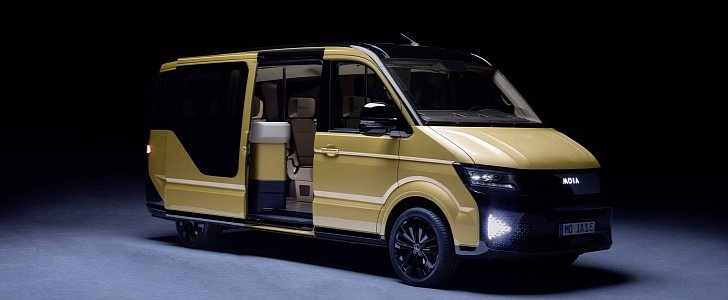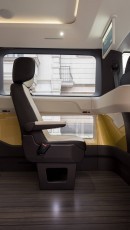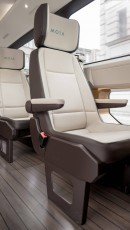When Volkswagen presented the Sedric concept, we all feared the worst. The German company was never primarily recognized for its gutsy designs, but that electric shuttle was more generic than a Golf ever was and ever will be.
It made the hatchback look like a masterpiece of originality and creativity, and that says something. Covered wheels? Check. White paint? Check. Blacked out details? Check. Sliding doors? Check. The Sedric had them all. The only thing it lacked was some character.
Volkswagen wasn't alone in developing the concept - it was helped by a Berlin-based mobility startup called Moia it had acquired earlier. Thankfully, this subsidiary of the German giant has now launched a new product it actually plans to build starting next year, and it looks very different.
That's because it is definitely based on a Volkswagen Crafter van, though some of the elements on the Sedric do make a comeback - such as the sliding door and the blacked out details in the front, rear, and around the windows. However, the intended effect of making the vehicle look more futuristic and less "van-like" is achieved.
Moia claims the vehicle - which had an incubation period of just ten months - has a maximum range of over 300 km (186 miles) and can charge to 80 percent in 30 minutes, meaning downtimes shouldn't be a problem.
The interior is designed to accommodate a maximum of six passengers with airliner seats (but with more legroom) fitted with the vital USB ports while a WiFi network will float around in the air inside the roomy cabin.
A fleet of 200 of them will go into service on the streets of Hamburg next year, and even though we like a lot of things about the project, we can't help feeling it's a bit wasteful. After all, it's built on a rather large van and can only serve six people at a time - that's two more than what a regular taxi will, albeit in a more cramped manner.
Building an EV based on existing, ICE-powered vehicles was proven not to be an effective solution, which means the Sedric might not be such a bad idea after all. However, we believe this is just the beginning and Moia is merely testing the water here, so to say. It's more about the principle than the vehicle itself at this point.
Volkswagen wasn't alone in developing the concept - it was helped by a Berlin-based mobility startup called Moia it had acquired earlier. Thankfully, this subsidiary of the German giant has now launched a new product it actually plans to build starting next year, and it looks very different.
That's because it is definitely based on a Volkswagen Crafter van, though some of the elements on the Sedric do make a comeback - such as the sliding door and the blacked out details in the front, rear, and around the windows. However, the intended effect of making the vehicle look more futuristic and less "van-like" is achieved.
Moia claims the vehicle - which had an incubation period of just ten months - has a maximum range of over 300 km (186 miles) and can charge to 80 percent in 30 minutes, meaning downtimes shouldn't be a problem.
The interior is designed to accommodate a maximum of six passengers with airliner seats (but with more legroom) fitted with the vital USB ports while a WiFi network will float around in the air inside the roomy cabin.
A fleet of 200 of them will go into service on the streets of Hamburg next year, and even though we like a lot of things about the project, we can't help feeling it's a bit wasteful. After all, it's built on a rather large van and can only serve six people at a time - that's two more than what a regular taxi will, albeit in a more cramped manner.
Building an EV based on existing, ICE-powered vehicles was proven not to be an effective solution, which means the Sedric might not be such a bad idea after all. However, we believe this is just the beginning and Moia is merely testing the water here, so to say. It's more about the principle than the vehicle itself at this point.





















